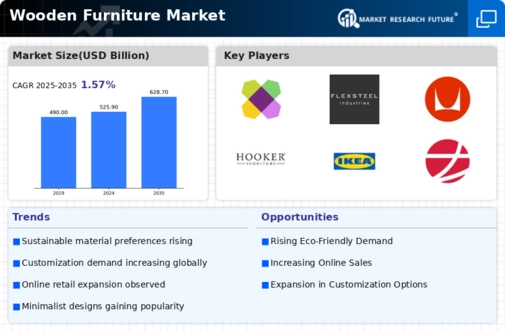North America : Market Leader in Innovation
North America is the largest market for wooden furniture, holding approximately 40% of the global share. The region's growth is driven by rising disposable incomes, urbanization, and a growing preference for sustainable materials. Regulatory support for eco-friendly practices further catalyzes demand, with initiatives promoting sustainable forestry and manufacturing processes. The U.S. and Canada are the primary contributors, with the U.S. alone accounting for about 30% of the market share. The competitive landscape in North America is robust, featuring key players like IKEA, Ashley Furniture Industries, and Steelcase. These companies leverage innovative designs and sustainable practices to capture consumer interest. The market is characterized by a mix of large manufacturers and local artisans, creating a diverse offering. The presence of established brands and a growing trend towards customization are shaping the future of the wooden furniture market in this region.
Europe : Sustainable Growth and Design
Europe is a significant player in the wooden furniture market, holding around 30% of the global share. The region's growth is fueled by increasing consumer awareness regarding sustainability and eco-friendly products. Regulatory frameworks, such as the EU Timber Regulation, promote responsible sourcing and manufacturing practices, enhancing market demand. Germany and Italy are the largest markets, together accounting for nearly 50% of the European share, driven by their strong design heritage and manufacturing capabilities. Leading countries like Germany, Italy, and France dominate the competitive landscape, with brands such as Natuzzi and Duresta Upholstery leading the charge. The market is characterized by a blend of traditional craftsmanship and modern design, appealing to a diverse consumer base. The presence of numerous small and medium enterprises alongside large corporations fosters innovation and customization, making Europe a hub for high-quality wooden furniture.
Asia-Pacific : Emerging Market with High Potential
Asia-Pacific is rapidly emerging as a key player in the wooden furniture market, holding approximately 25% of the global share. The region's growth is driven by urbanization, rising disposable incomes, and a growing middle class. Countries like China and India are at the forefront, with China alone accounting for nearly 20% of the global market. Regulatory initiatives promoting sustainable forestry practices are also contributing to market expansion, as consumers increasingly seek eco-friendly options. The competitive landscape in Asia-Pacific is diverse, with both local manufacturers and international brands like Kuka Home gaining traction. The market is characterized by a mix of traditional craftsmanship and modern design, catering to a wide range of consumer preferences. The presence of key players and a growing trend towards online retailing are shaping the future of the wooden furniture market in this dynamic region.
Middle East and Africa : Untapped Market Opportunities
The Middle East and Africa region is an emerging market for wooden furniture, holding about 5% of the global share. The growth is driven by increasing urbanization, rising disposable incomes, and a growing demand for luxury and customized furniture. Countries like South Africa and the UAE are leading the market, with significant investments in infrastructure and housing projects that boost furniture demand. Regulatory frameworks are gradually evolving to support sustainable practices, enhancing market appeal. The competitive landscape is characterized by a mix of local artisans and international brands. Key players are beginning to establish a presence in the region, focusing on high-quality materials and unique designs. The market is still developing, with significant opportunities for growth as consumer preferences shift towards premium and sustainable wooden furniture options. The potential for innovation and customization is high, making this region an attractive market for investors.

















